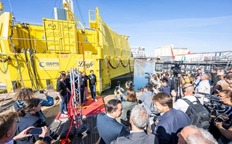- Sealhyfe will produce up to 400 kg of renewable green hydrogen daily, equivalent to 1MW of power.
- A six-month trial at the port of Saint-Nazaire will be followed by a 12-month offshore trial.
- The project involves partners like Centrale Nantes, Geps Techno, Plug Power, and Chantiers de l'Atlantique.
- The EU aims to produce 10 million tonnes of renewable hydrogen annually by 2030.

Introduction to Offshore Hydrogen Production
The pilot site aims to produce hydrogen using offshore wind turbines, addressing the global challenge of renewable hydrogen production. This initiative could enable countries with coastlines to access locally produced renewable hydrogen in industrial quantities, aiding in the decarbonization of transportation and industry.
Technological Challenges
The Sealhyfe platform will produce renewable green hydrogen at sea, operating automatically under extreme conditions. Key challenges include converting electrical voltage from floating wind turbines, desalinating and purifying seawater, and managing the platform's motion and environmental stress. The platform must also operate autonomously, with minimal physical intervention.
Collaborative Efforts
The project involves several partners: Centrale Nantes for offshore testing facilities, Geps Techno for the wave energy platform, and Plug Power for the electrolyser. Other contributors include Chantiers de l'Atlantique, Eiffage Energie Systèmes, the Port of Saint-Nazaire, and Kraken Subsea Solutions.
Trial Phases and Future Goals
The project will undergo a six-month trial at the port of Saint-Nazaire, followed by a 12-month offshore trial near a floating wind turbine. The goal is to gather data to design mature offshore production systems, aligning with the EU's objective to produce 10 million tonnes of renewable hydrogen annually by 2030. Sealhyfe aims to produce up to 400 kg of renewable green hydrogen daily, equivalent to 1MW of power.
